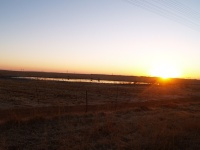

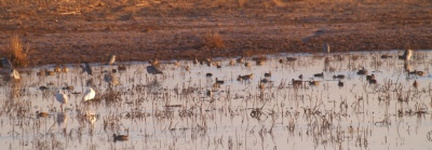
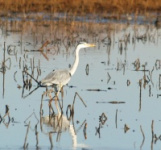
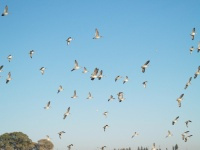
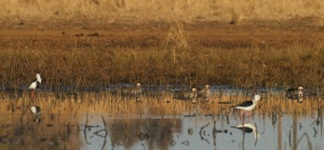
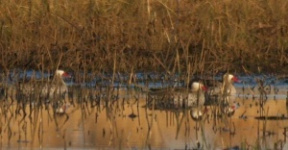
1. August 2010
Just hearing that it might be possible to see a Namaqua Sandgrouse on the western border of Gauteng was enough to get me planning a trip to the farm dam off the R500 between Carltonville and Ventersdorp. You travel along the N14 from Joburg and turn right on the R500 (it is at the crossroads where the N14 is closed) and then 1.5 kilometers along the R500 you turn left on a dirt road and travel for 8 kilometers until you reach a farm dam on the right.
I arrived at day break and found the dam teaming with birds - between 50 to 60 Red-billed Teal, a few White-faced Duck, two South African Shelduck, a few Yellow-billed Duck, eight Grey Heron, a Black-headed Heron, six Black-winged Stilt, two African Spoonbill, Cape Wagtail, Sacred Ibis, Egyptian Geese and Three-banded Plover. Here are some pics that I took:
What I did not see, rather frustratingly, was the Namaqua Sandgrouse around the dam, so I decided to explore the area around the farms further along the road before returning for another look. I saw Red-billed Quelea, Namaqua Dove and Black-shouldered Kite.
As I pulled up to the burn grass area in front of the farm house I saw a unfamiliar site - Temminick's Courser. There were two of them and when a Black-shouldered Kite flew overhead, being mobbed by Pied Crow, they quickly ducked down and were almost invisible. I sat waiting for either of them to budge - must have been about 10 minutes and they were not moving at all. I had taken a few pics but was not sure whether I had gotten the settings right in the each morning light - so I got out of the car to take some pics of the crouching birds - only to have them take off never to return! Talk about a lesson learnt the hard way!!! Next time I will be more patient. Here are the pics I did manage to get (sorry about the number of pics, but this Lifer seemed really special):
Before returning to the dam I also spotted Lilac-breasted Roller, Blacksmith Lapwing, Crowned Lapwing, a Rock Kestrel flying overhead, Capped Wheatear and White-browed Sparrow-Weaver.
When I returned to the dam, I heard the sound of Namaqua Sandgrouse at the dam but it was just too far away from my position on the road to capture any image of the birds who were all on the far side of the dam. So I decided to sneak up to an area of rocks half way between my location and the dam hoping to get better shots - it kinda worked as I could at least see that they were actually Namaqua Sandgrouse. I so enjoyed listening to their unique calls as they took off and circled the dam before leaving. Again excuse the number of pics, not all great, but I was totally captivated by these amazing birds!
A few other birds were spotted on and around the dam including Red-capped Lark, Blacksmith Lapwing, Speckled Pigeon, Hadeda Ibis, Cattle Egret, Pied Crow, Southern Red Bishop and Red-billed Quelea.
The adventurer in me kicked in and I decided to walk in the general direction of the other dam that I had seen close to the farm house on the same side of the road. There were a few cows on the way with attitude and their horns seemed really big as I passed them trying to let them know that I was not there to mess with their calves! The second dam turned out to be just as prolific with bird life as the first one was. There must have been around 100 White-faced Duck on this dam as well as South African Shelduck, Cattle Egret, Red-billed Teal, Cape Teal, Cape Sparrow, Black-winged Stilt (and a few juveniles too) and Namaqua Dove.
When I walked back to the first dam I spotted some waders that I could not identify - having looked at the pics that I took (sorry, but these are the best that I have) I am calling them Ruff - there were about 11 or 12 of them. I also saw a few Chestnut-backed Sparrowlark that I had seen for the first time just a few days ago!
I then decided to continue on the dirt road past the farmsteads and saw Rock Kestrel flying overhead (the markings on the tail feathers suggests that it is Rock and not Greater, if I am correct), White-browed Sparrow-Weaver and Capped Wheatear.
I then stumbled across a third dam on this road - and it too had lots of birds including Black-headed Heron, African Spoonbill (in my pic they clearly look like they are enjoying a joke at someone's expense), Grey Heron, Sacred Ibis and Blacksmith Lapwing.
As I was enjoying the water birds I happened to look along the dirt track and a raptor was snacking on a small bird about 50 metres ahead of me. I snapped a few shots that were at the edge of my camera's range and then it flew up to a telephone pole to continue it's meal. I slowly edged up to the pole and managed to get these pics. To be honest I am still trying to confirm whether it is Shikra or Little Sparrowhawk. I am not sure whether the first pic helps with the rear view, but no other close up pics show it's tail which would probably have been conclusive). Any thoughts?
I decided to follow the dirt track which was not a great road to put it mildly (let's just say that with I was happy to be driving a high clearance vehicle) and enjoyed good sights of Pied Starling, Ant-eating Chat, Cape Crow and Pied Crow (seemingly hanging out together), and finally I spotted the Greater Kestrel that is supposed to be in the area - and it was a great close up experience too! Of course there were African Stonechat along the way too! Oh, a high flying Black-chested Snake-Eagle was a tantalising sight but it never descended to my level despite any mind control techniques I tried to use on it! A noticed that Capped Wheatear are abundant in this area. Of great concern was the number of farmsteads that seem to have been burned to the ground with the wide spread fires that have taken place in this area. I am not sure how long ago it was!
Of course, I spotted a few Pipits and as always seem to struggle to identify them. I did whip out my video camera and film one - I'll have to edit it and upload it somewhere to get some fundis to take a look at it for me. I am so confused about behaviour being the key to ids - they all seem to scurry around and dig in the sand and then stand looking at me for about 20 seconds before flying off or just continuing to wander further and further away from me. Anyway, here are three poor quality pics of the first Pipit and then one of a second one.
I finally decided to head back as the road seemed to be getting rougher and rougher and my GPS system was not able to give me much help as to where it was heading. Just before I arrived at the farmsteads I took another look at the third dam and saw Namaqua Dove, Cape Teal and watched a Black-headed Heron eating a frog. It looked like quite a mouthful.
It was 2pm by now and I needed to drag myself away from this amazing location and head home. The last sighting of the day was a Francolin - that played Hide and Go Seek with me - so these are the best pics I was able to manage. I noticed that as it flew away from me its wings were rather rufous - but it seems like that is rather common with Francolins.
I am so grateful to Duncan from the SimplyBirding forum for proving directions to this spot!
2. September 2010
On Monday the 20th September 2010, after visiting Donaldson Dam outside Randfontein, I headed back to the farm off the R500 where I had seen Namaqua Sandgrouse some weeks back. It is a farm dam off the R500 between Carltonville and Ventersdorp. You travel along the N14 from Joburg and turn right on the R500 (it is at the crossroads where the N14 is closed) and then 1.5 kilometers along the R500 you turn left on a dirt road and travel for 8 kilometers until you reach a farm dam on the right.
On the way to the dam I heard a Northern Black Korhaan and saw it fly off and was a bit frustrated that all I got was a record pic. I continued hoping that I would get another sighting in the area - little did I know that by the end of the day I would be almost (not actually) sick of all the sightings of the species.
As has been reported on the GBT forum, the first dam was totally dry so I headed straight to the farm house to ask permission to view the dam near the homestead close up. I met the wife of the farmer, Gert Watson, and she very gladly said that I could drive down to the dam. I immediately saw good numbers of water birds, although not as many as on the previous trip. There was a huge group of White-faced Duck and Red-billed Teal and some South African Shelduck and Yellow-billed Duck, a few Red-knobbed Coot, Reed Cormorant, Blacksmith Lapwing and Egyptian Goose.
I spent some time scanning the shoreline of the dam and caught sight of Namaqua Dove, African Quailfinch, Pin-tailed Whydah, Red-billed Quelea and Chestnut-backed Sparrowlark:
I returned to my car for a bite to eat and was surprised by some also looking for a bite to eat. I initially thought it was a raptor but it turned out to be Cape Vulture.
I stopped by at the homestead to thank the farmer and he was home but occupied so after chatting a while with his wife said goodbye and got a bit side tracked by Red-headed Finch before I left the property.
I then headed off on the dirt road past the third dam (which was also dry) on my way to the Klerkskraal Dam on the N14 closer to Klerksdorp (that part of the trip will be described in a separate report). The scenery along the way excellent. Previously there was a lot of burn grass, which had since started to produce new green shoots. Along the way I saw Namaqua Dove, Crowned Lapwing, Capped Wheatear, White-browed Sparrow-Weaver, Southern Masked Weaver, Spike-heeled Lark, Pied Starling and Ant-eating Chat.
I noticed a pair of birds that I could not identify - the size of a Mynah - they turned out to be, when I checked my pics on my laptop, Pied Starling.
This dirt road ended at a T-Junction where I saw a good number of Common Ostrich on a farm on the left - and I paused to take a pic of the road that I had just travelled along.
I turned left towards the N14 and very soon had another sighting of Northern Black Korhaan - but again it was flushed in the fields and flew away from me - here is all I managed to capture (would I get lucky later? Time was running out!):
An Ant-eating Chat caught my eye as it perched on a fence next to the road with some nest building material in it's mouth - and suddenly I spotted on the road side in front of me a Northern Black Korhaan. Was it going to fly away before I could get a shot? Not this time. It slowly walked away from me - but at least I got some shots. I decided to push the envelope and play a recording from Roberts for a few seconds and that did the trick - It came back to the road side, walked through the fence not more than 15 metres from my car - took one look in my direction - realised I was an Eastern White Toyota and not good looking enough (I am sure I saw a look of disgust in it's eyes!) - before flying off to find a better mate in the fields to the west.
As I followed a bend in the road a bit further on the road, I spotted what I initially thought might be Natal Spurfowl. It went and ducked down in the grass on the side of the road - thinking it was invisible - and when I pulled over I noticed that there were 2 birds and they were definitely Francolin and not Spurfowl. Only later as I poured over the pics did I eliminate some species and conclude that it was Orange River Francolin. Somehow I lost sight of the second bird (right under my nose!!!) and only when I farmer in a bakkie came speeding past did the Francolin and it's mate decide to take off (and only then did I see the second bird which must have been ducking behind a tuft of grass right next to my car.
I noticed a small group of Pied Starling on a mound of sand and soon after that arrived at the N14 tar road that lead to Klerksdorp. Here is a pic of the intersection - the road I had just travelled on was marked Boons at this intersection as you can see from the sign board.
Not far from this intersection, on the road to Klerkskraal Dam I spotted a raptor that I subsequently identified as Greater Kestrel. I got a few shots of it on the trip to the dam (not as close as I would have liked and it flew off after a minute or so) but was surprised to see it on my way back and it hung around until I headed back towards Joburg. It was a special experience to watch it for a good period of time (How long? about 2 Gigabytes worth of time). At one point I had to look away as it scratched it's eye with it's talons - dangerous stuff.
3. September 2011
I returned to this spot on Monday the 19th of September 2011 and again found the dams all dried up which seriously limited the amount of bird life in the area. Some of the highlights during my drive through this area include: Little Bee-eater, Cape Crow, Orange River Francolin, Northern Black Korhaan, Crowned Lapwing, Rufous-naped Lark, Red-capped Lark, African Pipit, Cape Longclaw, Neddicky, Zitting Cisticola, African Quailfinch, Scaly-feathered Finch, Chestnut-vented Tit-babbler, African Stonechat, Southern Masked Weaver, White-browed Sparrow-Weaver and Capped Wheatear. Here are a few pics that I managed to get:
On my way to the town of Boons to visit the Bosparadys Dairy dams I stumbled across a wetland project next to Mathopestad. The water levels were really low so the bird life was not great. I did spot Sacred Ibis, Capped Wheatear, Red-billed Teal, Reed Cormorant, Blacksmith Lapwing, White-rumped Swift, White-throated Swallow, Cattle Egret and Greater Kestrel.